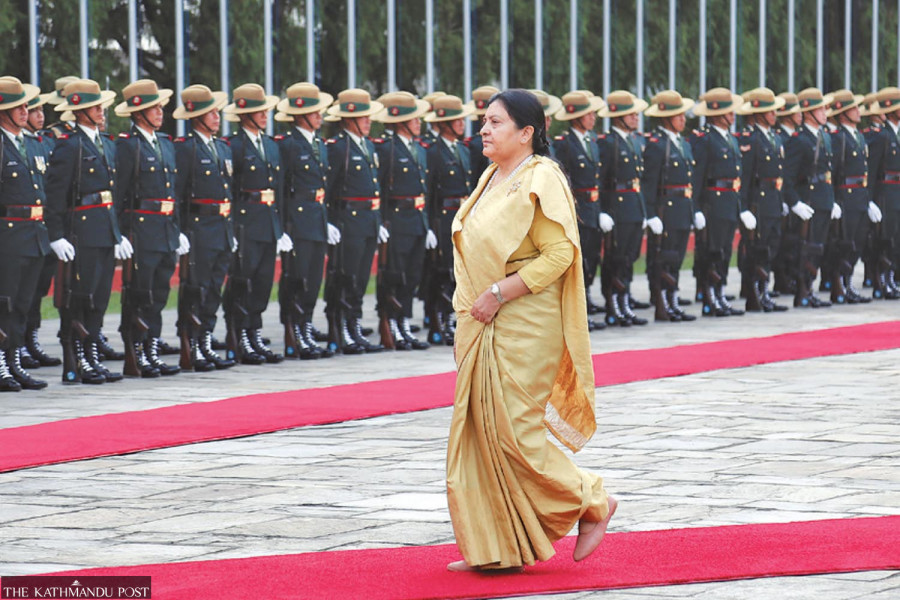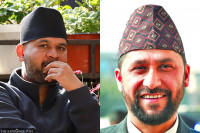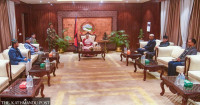Politics
What makes the post of President increasingly attractive to political parties?
The moves of the two Presidents have sent a message that the role of the head of the state is crucial, and more so when there is a hung parliament.
Binod Ghimire
The constitution envisions the President as the head of the state and the custodian of the statute.
Largely, there is no discretionary authority the President enjoys, whose primary responsibility is to authenticate the Cabinet’s decisions. However, different moves of the first president Dr Ram Baran Yadav and the incumbent Bidya Devi Bhandari courted controversy for their alleged failures to act as custodian of the constitution and their refusal to work in tandem with the Cabinet.
In 2009, Yadav stalled the then prime minister Pushpa Kamal Dahal’s decision to sack the army chief Rookmangud Katawal and the move sparked controversy. Bhandari on the other hand is accused of colluding with CPN-UML chair KP Sharma Oli and refusing to authenticate the current government’s decisions, the latest being her refusal to issue an ordinance on citizenship.
The moves of the two Presidents have sent a message that the role of the head of the state is crucial, and more so when there is a hung parliament. That’s why the parties are discussing who to appoint to the key position even before they have reached an agreement on the prime ministerial candidate, according to experts.
“The constitution gives ceremonial status to the President. However, the role of the former and the current presidents showed they can sometimes be manipulative,” Sanjeev Humagain, a faculty member of the PhD programme for Political Science and International Relations at the Tribhuvan University, told the Post. “Now some leaders are eying the presidency and want to install someone close and loyal, hoping that they would be useful in crucial situations.”
Humagain says the ambition the Presidents have demonstrated so far hasn’t done good to both the individual and the institution.
The President replaced the king as the head of the state after Nepal was declared a republic in 2008. Yadav, a Nepali Congress leader, became the first President of the country. He was replaced by Bhandari, a leader from the CPN-UML, in October 2015. Her second tenure ends in March.
Article 61 of the constitution says the role of the President is to promote national unity, abide by the statute and also protect it.
“The President primarily implements the decision of the Cabinet,” Purna Man Shakya, a senior advocate and professor at Nepal Law Campus told the Post. “The President can ask the government to reconsider its decision if s/he feels it is against the constitution. But there is no authority to reject the Cabinet’s decision.”
However, President Bhandari has on different occasions refused to do so and this has prompted the parties to look for a non-political candidate for the position, he says. Though the parties are yet to reach a conclusion, they are considering non-political figures like former chief justice Kalyan Shrestha, among others, for the post.
A section of the political parties says the President must be from a political background. Among politicians, former prime minister and CPN (Unified Socialist) leader Jhalanath Khanal and Nepali Congress senior leader Ram Chandra Poudel are eying the position. Even Unified Socialist chair Madhav Kumar Nepal is reportedly being considered as a possible candidate for the top post.
In the views of some of the experts, the President’s position is becoming more crucial as politics is becoming increasingly fluid both at the federal and provincial levels. The five-party ruling alliance is short of two seats for a simple majority, which is 138, in the House of Representatives. And in provinces, the alliance doesn’t have a majority in three.
It needs to bring some fringe parties on board both at the federal and provincial levels to form governments. This can lead to a situation of a series of episodes of political disputes and making and unmaking of governments. The President can play an important role in such an atmosphere.
Mohan Acharya, a constitutional lawyer, said many leaders want the position because it is largely secure for five years while a prime minister rarely gets an opportunity to run the government for the full term. Also, the President has their role to play when presidential rule is imposed in provinces in the event of political instability.
Article 232 (3) of the constitution says that the President can dissolve a provincial assembly if the assembly acts in a way to undermine the sovereignty and territorial integrity of the country. But a new assembly must be elected within six months of the dissolution.
“The President's position despite being ceremonial is crucial. The head of the state should work to maintain the dignity of the position by acting in line with the spirit of the constitution,” said Acharya. “Let’s expect the parties to pick the right candidate for the position.”




 8.12°C Kathmandu
8.12°C Kathmandu


.jpg&w=200&height=120)












